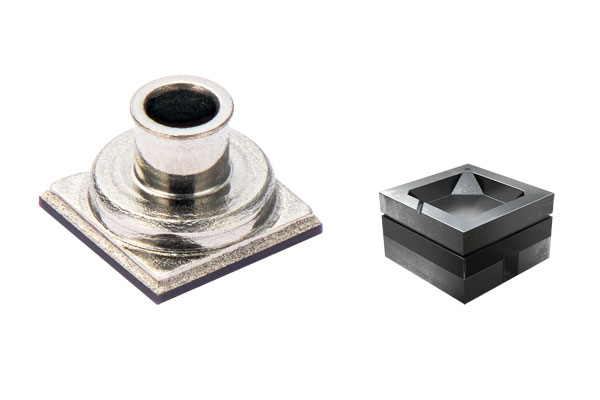Pressure Sensor


CEATEC 2023
INDEX
Proximity and force sensor
Proximity and force sensor: Continuous sensing from object proximity to contact
Further expansion of measurable range
Invisible ID tags
Invisible ID tags: Affixing an ID linked to data unobtrusively on the surface of an object
Using colloidal crystals with systematically arranged microscopic particles as ID tags
Ability to discriminate an ID among 10 quadrillion patterns from a transparent tag 1 mm in diameter
Digitization of business and operations is proceeding rapidly in all aspects of life, from people’s daily lives, to the business operations of companies, to social activities of all kinds. Simulatenously in the human–machine interface (HMI) area, a trend toward linking objects in the real world and digital data in the cloud is gaining popularity as a way to eliminate barriers between operations performed by humans and by machines. In addition, for objects manufactured, distributed, and used in the real world as well, interaction between physical space and cyberspace, and the worldwide trend toward sustainability are ushering in an age in which traceability is demanded for an array of products of all kinds.
Murata Manufacturing (Murata) is supporting the digitization of society by developing products such as new sensors enabling HMIs that closely link humans and machines, and new ways to link digital data and objects of all kinds. At CEATEC 2023, held at Makuhari Messe from October 17 to 20, 2023, Murata unveiled some of the new technologies it has developed to support the advancement of the digital society. Among the developers of new technologies on display at the Murata booth, we interviewed Mr. Watanabe of the Applied Technology Development Department, Device Center Technology & Business Development Unit, who helped develop a “proximity and force sensor” that closely connects humans and machines and paves the way to the realization of new HMIs, and Mr. Shirai and Mr. Sumiyoshi, of the Material Technology Center Material Process Development Department, Technology & Business Development Unit, who helped develop “invisible ID tags” that assign an ID linked to data unobtrusively on the surface of an object.
--What are the functions provided by the proximity and force sensor that you are developing?
Watanabe: The goal of the proximity and force sensor we are developing is to sense the course from proximity to contact with an object. For example, it can seamlessly sense the movement of fingers when one’s hand approaches an object and the way that force is applied after making contact with the object. Previously, it was necessary to use both a proximity sensor and a force sensor to sense the phenomenon at the moment an object is touched. Our proximity and force sensor can accomplish this with a single sensor.
--What is the operating principle used to perform measurement?
Watanabe: The sensor shines near-infrared light on the object being measured and, based on the principle of triangulation, the light that is reflected back is used to calculate the distance to the target object.
Conventional methods of measuring distance include IR-TOF (infrared time-of-flight), which shines infrared light on the target object and calculates the distance based on the amount of time until the reflected light arrives, the use of ultrasonic sensors, and analyzing images captured by a camera. The principle of the triangulation method used by the proximity and force sensor improves the precision of close-distance measurement, and this enables accurate measurement of much closer distances, such as proximities of 0 to 20 or 30 mm, than is possible using conventional methods (Figure 1). Another advantage is that the reflectance of the target object has little effect on the measurement because the medium used for measurement is near-infrared light and measurement is based on the principle of triangulation.

Also, an additional sensor for contact force measurement, employing the same mechanism as the sensor for distance measurement, is mounted on the same sensor module. This sensor is covered with an elastic body, and it measures the contact force by using the same principle to gauge the displacement arising from the applied load when the target object comes in contact with the elastic body. The measurable load range of the sensor we developed is 0 N to 12 N.
--What sorts of applications do you envision for the sensor?
Watanabe: We envision applications such as VR controllers. An immersive experience is important for VR applications, and in order to heighten this immersive experience, it is necessary to minimize the gap between the movements of the player’s hands and movements in virtual space. We believe that it will be possible to make the experience more immersive by heightening the link with sensors that detect motion and force.

We also think that the sensor can be used to create an HMI, using a simple system configuration, enabling users to operate machines such as robots as if they were moving their own hands or feet. The sensor module uses sensors employing the same measuring principle and mechanism to track the course of approaching objects and to detect the force applied after contact. The same algorithm is used for sensing of both distance and load, so simple control is sufficient to sense the approach of the target object as well as phenomena at the moment the object is touched.
We expect that the proximity and force sensor can be used in a large number of applications, including the automated or autonomous functioning of robots capable of intricate operations, joint operation by persons located in locations remote from one another, and VR-related applications involving manipulation of digitized objects in a virtual space.
--Moving forward, what advances do you predict for this new concept in sensors?

Watanabe: We are currently working on the development of an improved version that extends the measurable distance range to 0 to 100 mm and the measurable load range to 0 N to 15 N. We have already created a prototype of a sensor that is 8 × 11 × 4 mm in size. Since it uses the principle of triangulation, it is necessary to increase the size of the sensor module in order to extend the measurable range of improved versions. However, by making use of Murata’s accumulated technology for manufacturing compact sensors, we believe that we could reduce the size of an improved model to 12 × 12 × 6 mm.
--In what sort of places do you expect the technology of the invisible ID tags you are developing to be put to use?
Shirai: The technology of our invisible ID tags makes it possible to apply a transparent and tiny ID tag to the surface of a product in a way that is unobtrusive and hardly noticeable.
Currently, to assign and manage the serial numbers of industrial goods, a barcode, RFID tag, or the like is affixed to the product. These are then read to link each individual product to data in the cloud. However, affixing a barcode or RFID tag requires covering up a substantial amount of the surface area, making the product less attractive. In particular, it is not practical to apply such stickers or tags to products such as jewelry for which sophisticated design and texture are essential. But it is precisely products such as jewelry, whose genuineness must be verified and where there is an interest in preventing problems such as resale at high prices through secondary channels, that are most in need of digitized data such as authentication information or ownership history. The newly developed invisible ID tags solve these problems.

--What sort of technology did you use to make these transparent and tiny ID tags?
Sumiyoshi: We used a material known as a “colloidal crystal,” which has a structure consisting of microscopic particles that are systematically arranged two-dimensionally in hardened resin, as an ID tag.
Colloidal crystal is made by dispersing microscopic particles a few nanometers or micrometers in size in resin, and it has a structure quite like crystal, in which the distance between the particles and their arrangement is arranged in a fixed and regular manner. We control the structure of the colloidal crystal so that its appearance is as close to transparent as possible. But when you shine light on a colloidal crystal for verification, the light waves reflected from the surfaces of the individual microscopic particles interfere with each other, and strong light traveling in specific directions either passes through or is reflected due to diffraction. This causes a unique pattern to be formed.
The particles in a colloidal crystal are systematically arranged, but if the distance between the particles or their arrangement is altered artificially, it is possible to generate crystals with different local characteristics, each of which has a different pattern. This is just like a fingerprint, and by reading the patterns and assigning codes to them it is possible to use colloidal crystals as ID tags for individual identification.

--This is an ingenious technology. What are the special features of this technology in comparison with barcodes or RFID tags?
Shirai: The biggest advantage is the ability to create ID tags that are tiny and invisible to the eye since they are transparent. Such ID tags can be incorporated unobtrusively in a location where they merge into the design, such as the center hub to which the hands of a watch are attached. A space 1 mm in diameter is sufficient for any one of approximately 10 quadrillion patterns corresponding to IDs. Another big feature of this product is that copying is impossible, because the individual arrangement of the microscopic particles is used for authentication.

In addition, since light is used for authentication, rather than radio waves, as with RFID tags, our invisible ID tags are suitable for use on products made of metal. They can also be applied to glossy materials.
We expect to start developing a market for invisible ID tags around 2025 or so, starting with products where the design aspect is key, such as jewelry and watches. We are thinking of offering an integrated solution combining all aspects from technology for applying invisible ID tags to products to a system for reading IDs from tags.
--This product, which makes use of the unique properties of a particular material, seems a little bit out of character for Murata. How were you able to develop such a technology?
Sumiyoshi: Colloidal crystals can be seen as an extension of our technology for evenly distributing microscopic particles of uniform size, which Murata perfected in connection with the manufacture of multilayer ceramic capacitors (MLCCs). To this we associated optical characteristics and came up with the concept of invisible ID tags. In particular, I think the technology for arranging microscopic particles systematically and making the crystals transparent and suitable for affixing to products is something that no other company would have been able to manage.
The “proximity and force sensor” and “invisible ID tags” are technologies that have the potential to give rise to new usage scenarios as our digital society continues to develop. Both already have likely applications already, but there are surely many more applications out there that Murata has not even imagined.
We hope you will work with us to create new applications that make use of technologies that only Murata could create while supporting and advancing the digitization of society.

*The content of this article is current as of the publication date. Product specifications and external appearance subject to change without notice.